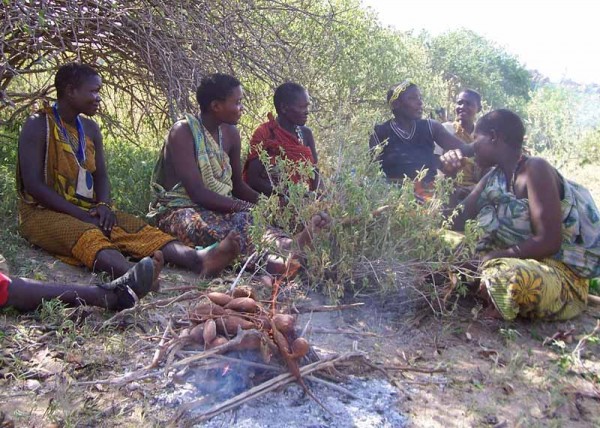
The new study is the first to report on the gut bacteria of hunter-gatherers, who hunt and forage for most of their foods, just as our ancestors did before the invention of agriculture 10,000 years ago. Until now, studies of gut bacteria have focused on people who live in industrialized nations, many of whom eat diets high in sugar, salt, and fat. These diets have shifted the type of bacteria in our guts, known as the microbiome. Gut bacteria respond rapidly to changes in their host's diet, and humans who live in rural areas and eat fewer processed foods have more diverse microbiomes. Conversely, researchers also have found an association between less diversity in the microbiome and diseases of the colon, such as Crohn's disease and colon cancer.
In the new study, an international team worked together to collect and analyze the bacteria in fecal samples from one of the last remaining hunting and gathering communities in the world, the Hadza people of Tanzania. As part of her thesis project, Stephanie Schnorr, a graduate student at the Max Planck Institute for Evolutionary Anthropology in Leipzig, Germany, had the unenviable task of asking the Hadza for fecal samples. But when her interpreter explained what she wanted, she lucked out when one elder, named Panda, said: "We normally give it to the ground. We'll give it to her instead."
Once Schnorr had samples from 27 Hadza, aged 8 to 70 years, she sent them in frozen or dried form to the University of Bologna in Italy, where a team specializes in the extraction and sequencing of DNA from bacteria. The team identified the bacteria using the Hadza's DNA and also analyzed the type of nutrients in the fecal matter, including microbial metabolites, which are fatty acids that microbes use in the gut to get their energy. When they compared this DNA from the Hadza with those of Italians, the team found that the Hadza have a more diverse gut microbe ecosystem. What's more, when they also looked at those bacteria in two groups of farmers from Africa, they found that the Hadza were the only people who lacked a type of bacteria commonly added to probiotic drinks - known as Bifidobacterium - perhaps because it is associated with dairy products, which the Hadza do not consume. The Hadza also had high levels of bacteria like Treponema, which is considered a sign of disease in Western populations because different types are linked with systemic lupus and periodontitis, as well as syphilis. Yet, the Hadza experience almost no autoimmune disorders, obesity, or diabetes, which are associated with imbalances of different types of gut bacteria.
"We must redefine our notions of what is considered healthy and unhealthy, since these distinctions are clearly dependent on diet," says Alyssa Crittenden, a nutritional anthropologist at the University of Nevada, Las Vegas, and lead author of the study, which appears online today in Nature Communications.
The other big surprise was that the Hadza men and women had significant differences in the type and amount of gut bacteria - a sex difference never observed before. The disparity reflects sexual divisions of labor - the Hadza men hunt and eat meat and honey, whereas the women primarily dig up tuberous plants. Both sexes eat more of what they collect, and the women eat more fibrous tubers. "We think that the bacteria the women have are particularly good at digesting fiber," says paleobiologist Amanda Henry of the Max Planck. The team is now testing the Hadza gut bacteria in lab studies to see if they are more efficient at breaking down fiber than gut bacteria from Westerners are.
Other researchers also note that previous studies suggested that humans had less diversity in their gut microbiome on average than other primates. But that may be partly because researchers have not collected fecal samples from humans eating diverse diets and living in a wide range of habitats. "This is a really important study because it helps us find the range of variation in the microbiome in humans," says biological anthropologist Steven Leigh of the University of Colorado, Boulder.
Such information will help researchers understand how our ancestors adapted to new habitats and diets as they spread around the world, because their gut bacteria coevolved with them as their diets changed. And it may be critical to understand that spectrum of diversity and how different species of bacteria interact with each other (and, perhaps, resist antibiotics) before consuming probiotics produced on "an industrial scale," as if one type fits all, Leigh says.



Reader Comments
to our Newsletter